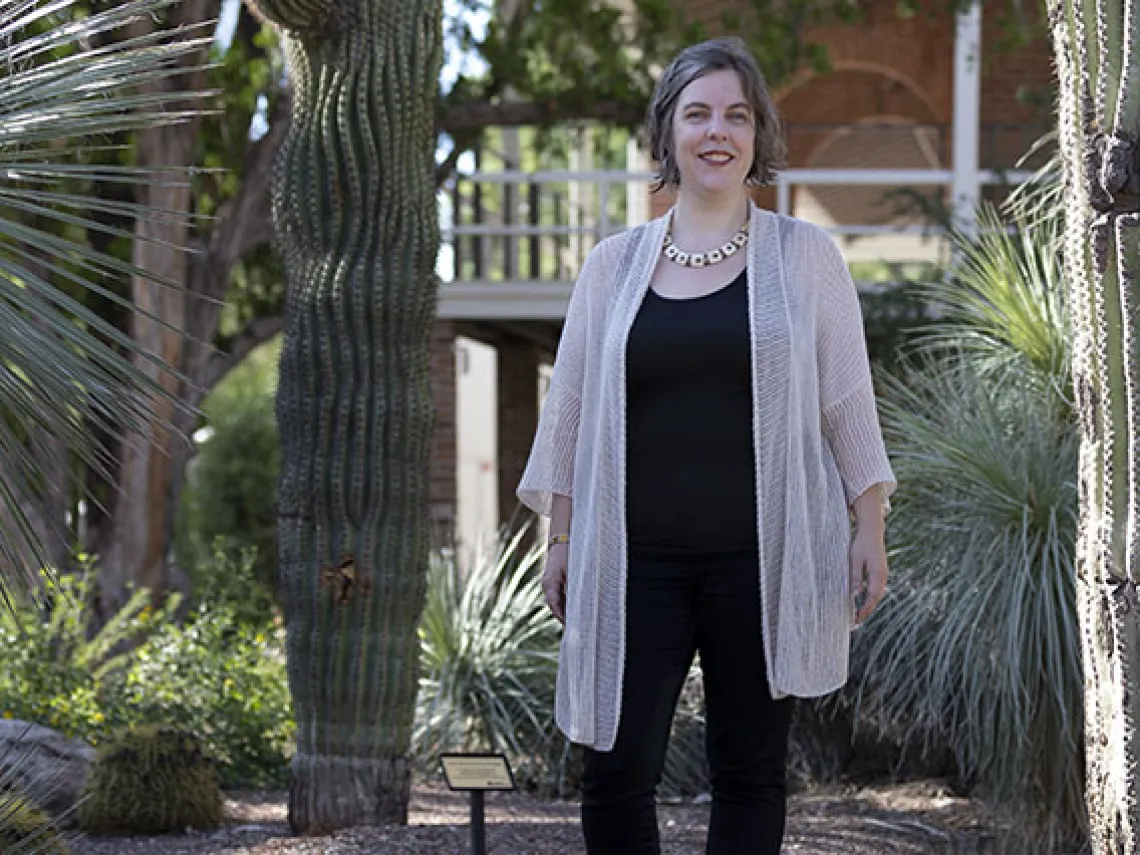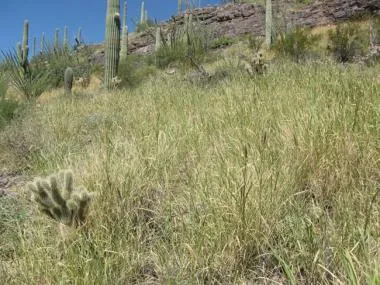Bringing Policy and Law Into Fight Against Buffelgrass
Using buffelgrass as the subject of a new study, University of Arizona researchers hope to develop the tools and knowledge to enable proactive management of emerging threats from invasive species.

Elizabeth Baldwin is principal investigator of an NSF grant to predict effective governance strategies for managing invasive species.
Photo by Anna Augustowska
The spread of buffelgrass "rivals climate change and water scarcity as our region's most pressing environmental issue," according to the Arizona-Sonora Desert Museum.
Buffelgrass, an invasive species native to Africa, Asia and the Middle East, was introduced in Arizona in the 1930s for cattle forage and erosion control. Buffelgrass increases the risk of wildfires and is a threat to native saguaros. It reduces the biodiversity of the desert, hogging space, water and nutrients.
Now, an interdiscplinary team of researchers from the University of Arizona is researching solutions to the buffelgrass threat and creating a predictive model that incorporates the often missing variables of policy and law.
The team, consisting of faculty from the College of Social and Behavioral Sciences and the College of Agriculture and Life Sciences, received a $1.58 million grant from the National Science Foundation's CNH2: Dynamics of Integrated Socio-Environmental Systems program.
"The CNH2 program funds convergent research on incredibly complex socio-environmental systems that has the potential to make transformative change, better preparing us to meet real-world sustainability challenges," said Jaqueline Vadjunec, NSF program officer for the CNH2 program. "This award to the University of Arizona on the problem of invasive species epitomizes this effort to bring clarity from complexity on issues of real importance."
The principal investigator of the grant is Elizabeth Baldwin, assistant professor in the School of Government and Public Policy. Baldwin, who has both a doctorate and a law degree, researches environmental, energy and water policy in the United States and internationally.
Other team members include Adam Henry, associate professor in the School of Government and Public Policy; Mitchel McClaran, professor in the School of Natural Resources and the Environment; Elise Gornish, Cooperative Extension specialist in the School of Natural Resources and the Environment; and Aaron Lien, assistant research scientist in the School of Natural Resources and the Environment.
"Protecting the biodiversity of our unique area of the world is critical. This invasive species is contributing to some very serious environmental problems, including wildfires, and its eradication is vitally important," said University of Arizona President Robert C. Robbins. "Dr. Baldwin and her team will take an inclusive and collaborative approach, leveraging the university's expertise in natural resources, environmental law and public policy, plus its long history of working with community partners. That is exactly how we need to tackle challenges of this scale, and I look forward to seeing the impact they have on a problem that affects much of Southern Arizona."
Creating a Predictive Model
Researchers already know how to get rid of buffelgrass, but killing an invasive species doesn't work when not everyone is doing it, because the plants will just move.

"The real challenge becomes how do you get people to work together when those people have wide-ranging interests and different goals, economic incentives and rules that they're following in terms of laws and governance," Lien said.
In addition, policymakers' ability to address the threat of invasive species is limited by incomplete knowledge – particularly knowledge of how ecological factors, land-use practices, social attitudes and behaviors, and policy responses can affect ecological systems.
To address these issues, the University of Arizona team will create a spatial-human-ecology model to predict interactions between natural and human systems. Focusing on Pima County, the team will conduct experiments on how buffelgrass responds to different ecological conditions and to various types of treatment.
"It's kind of like the Sims video game," Baldwin said. "You've got agents that operate in a given landscape, and you can program how they respond to different stimuli."
Baldwin said that other agent-based models have left out key variables, such as policies and laws.
"They assume that there are no laws," Baldwin said. "Not only do laws exist and shape the way people behave, but they are a primary tool for solving problems."
The team will interview public land managers, homeowners association leaders and developers to learn what shapes decisions on whether and how to treat buffelgrass. What do these agents perceive as the benefits and costs of treating buffelgrass? And what factors – better instructions, increased funding and regulations with fines, for example – might change that decision?
The team will also consult with community experts about policy ideas.
"We will talk to people who probably have excellent ideas about policy changes that, if they were enacted, might really make a difference because these people have been working on this issue for 20 years," Baldwin said.
The goal of the research is to provide resource managers with the necessary knowledge and tools to enable proactive management of emerging threats.
Kim Franklin, conservation research scientist at the Arizona-Sonora Desert Museum, has been working closely with Baldwin on this issue and the grant proposal.
"A large group of stakeholders has been involved in managing the buffelgrass invasion for more than a decade. We have made much progress, yet buffelgrass has invaded vast areas in our jurisdictionally complex landscape," Franklin said. "The success of managing buffelgrass very much depends on how a large number of actors work together consistently under a shared and effective strategy.
"This project allows us to explore ways of bringing about the type of collaboration needed to solve spatially extensive ecological problems and is an important step toward realizing the collaborative power we have in managing the natural resources in this part of the Sonoran Desert."
The NSF grant stemmed from Bridging Biodiversity and Conservation, an interdisciplinary initiative at the University of Arizona supported by the Institute of the Environment. Baldwin also previously received faculty seed grants from the university Office of Research, Discovery and Innovation and from the Institute of the Environment.
"This project goes to the heart of the university's land-grant mission, emphasizing the importance of research for the benefit of Arizona," said Elizabeth Cantwell, senior vice president for research and innovation. "Given societal shifts, demographic changes, enhanced technologies and global and cross-border connections, the mission today is also about having simultaneous local and global impact in a broad range of areas that include invasive species and how people and the environment interact."

